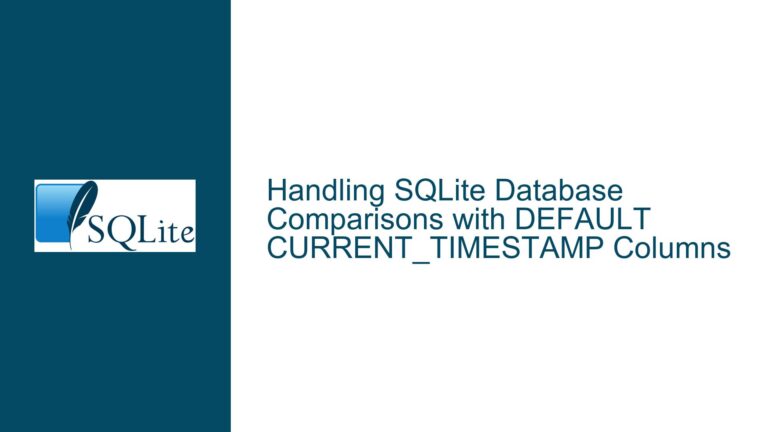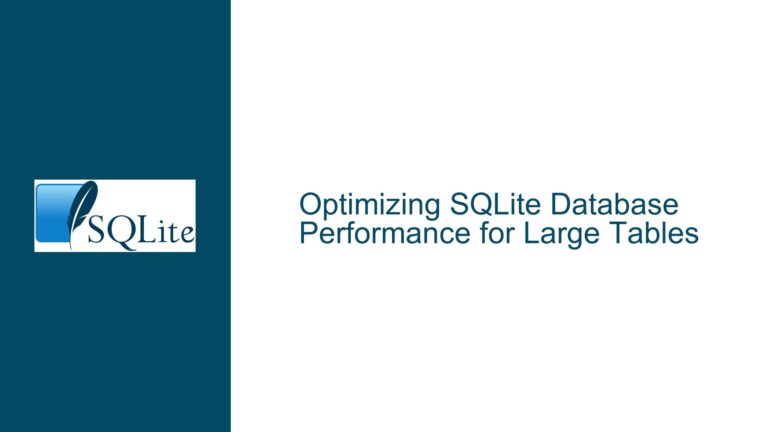Optimizing SQLite DELETE Query Performance with Indexes and Version Upgrades
Slow DELETE Query Execution Due to Missing Indexes and Outdated SQLite Version
The core issue revolves around a slow-performing DELETE query in SQLite, specifically targeting the points_11 table where rows are deleted based on a condition involving the values_11 table. The query in question is:
DELETE FROM points_11 WHERE uint64_ID NOT IN (SELECT uint64_pointIDX FROM values_11);
This query is designed to delete rows from points_11 where the uint64_ID does not exist in the uint64_pointIDX column of values_11. The execution time of this query is reported to be around 4.5 seconds, which is significantly slow given the dataset sizes: 1,440 records in points_11 and 46,049 records in values_11.
The primary factors contributing to this performance bottleneck are the absence of an index on the uint64_pointIDX column in the values_11 table and the use of an outdated SQLite version (3.6.14.2). Without an index, SQLite must perform a full table scan on values_11 for each row in points_11, leading to a quadratic time complexity. Additionally, older versions of SQLite lack several optimizations that could significantly improve query performance.
Impact of Missing Indexes and Outdated SQLite Versions on Query Performance
The absence of an index on the uint64_pointIDX column in the values_11 table forces SQLite to perform a full table scan for each row in points_11. This results in a time complexity of O(n*m), where n is the number of rows in points_11 and m is the number of rows in values_11. In this case, with 1,440 rows in points_11 and 46,049 rows in values_11, the query must perform approximately 66,310,560 comparisons, which is computationally expensive.
Moreover, the SQLite version in use (3.6.14.2) is from 2009 and lacks several optimizations that have been introduced in later versions. For instance, SQLite 3.35.0 introduces optimizations that can transform a NOT IN subquery into a more efficient NOT EXISTS subquery, reducing the number of bytecode instructions executed per row in points_11. Additionally, newer versions of SQLite include various micro-optimizations that can significantly improve query performance, especially for complex queries involving large datasets.
The combination of missing indexes and an outdated SQLite version creates a perfect storm for poor query performance. The lack of an index forces SQLite to perform unnecessary full table scans, while the outdated version prevents the query optimizer from applying modern optimizations that could mitigate the performance impact.
Implementing Indexes, Upgrading SQLite, and Optimizing Query Structure
To address the performance issues, several steps can be taken:
Step 1: Create an Index on the uint64_pointIDX Column
The first and most immediate step is to create an index on the uint64_pointIDX column in the values_11 table. This index will allow SQLite to perform an index lookup instead of a full table scan, significantly reducing the number of comparisons required. The index can be created using the following SQL statement:
CREATE INDEX idx_values_11_pointIDX ON values_11(uint64_pointIDX);
After creating the index, the DELETE query should be rewritten to take advantage of the index. The NOT IN subquery can be replaced with a NOT EXISTS subquery, which is often more efficient:
DELETE FROM points_11
WHERE NOT EXISTS (
SELECT 1
FROM values_11
WHERE points_11.uint64_ID = values_11.uint64_pointIDX
);
This query structure allows SQLite to use the index on uint64_pointIDX to quickly determine whether a row in points_11 should be deleted, reducing the time complexity from O(nm) to O(nlog(m)).
Step 2: Upgrade to a Newer Version of SQLite
Upgrading to a newer version of SQLite, such as 3.35.0 or later, can provide significant performance improvements. Newer versions of SQLite include various optimizations that can improve query execution time, especially for complex queries involving large datasets. The upgrade process is straightforward, as SQLite maintains backward compatibility with older database files and C/C++ interfaces. Simply recompile the application with the newer SQLite library to take advantage of these optimizations.
Step 3: Analyze Query Execution Plan
After creating the index and upgrading SQLite, it is essential to analyze the query execution plan to ensure that the index is being used effectively. SQLite provides the EXPLAIN QUERY PLAN statement, which can be used to inspect the execution plan of a query. For example:
EXPLAIN QUERY PLAN
DELETE FROM points_11
WHERE NOT EXISTS (
SELECT 1
FROM values_11
WHERE points_11.uint64_ID = values_11.uint64_pointIDX
);
The output of this statement will provide insights into how SQLite is executing the query, including whether the index on uint64_pointIDX is being used. If the index is not being used, it may be necessary to further optimize the query or investigate other potential bottlenecks.
Step 4: Consider Foreign Key Constraints
If the relationship between points_11 and values_11 is such that rows in points_11 should only exist if there is a corresponding row in values_11, it may be beneficial to enforce this relationship using foreign key constraints. This approach ensures that rows in points_11 are automatically deleted when the corresponding row in values_11 is deleted, eliminating the need for the DELETE query altogether. Foreign key constraints can be enabled in SQLite using the following PRAGMA statement:
PRAGMA foreign_keys = ON;
Once foreign key constraints are enabled, the relationship between points_11 and values_11 can be defined using a foreign key:
CREATE TABLE points_11 (
uint64_ID INTEGER PRIMARY KEY,
uint_UTC INTEGER,
uint_OSC INTEGER,
uint_storeUTC INTEGER,
uint_storeOSC INTEGER,
text_timesource TEXT,
text_status INTEGER,
uint_job INTEGER,
blob_raw BLOB,
FOREIGN KEY (uint64_ID) REFERENCES values_11(uint64_pointIDX) ON DELETE CASCADE
);
With this setup, deleting a row from values_11 will automatically delete the corresponding row in points_11, ensuring data integrity and eliminating the need for the DELETE query.
Step 5: Optimize Data Access Patterns
In addition to the above steps, it is important to consider the overall data access patterns and schema design. For example, if the points_11 table is frequently queried based on the uint_UTC column, it may be beneficial to create an index on that column as well. Similarly, if the values_11 table is frequently queried based on multiple columns, a composite index may be more efficient than individual indexes.
Step 6: Monitor and Profile Query Performance
Finally, it is crucial to continuously monitor and profile query performance, especially after making changes to the schema or upgrading SQLite. SQLite provides several tools for profiling and monitoring query performance, including the .timer command in the SQLite shell, which can be used to measure the execution time of queries. Additionally, third-party profiling tools can be used to gain deeper insights into query performance and identify potential bottlenecks.
By following these steps, the performance of the DELETE query can be significantly improved, reducing execution time from 4.5 seconds to a fraction of a second. The key is to ensure that the necessary indexes are in place, the SQLite version is up-to-date, and the query structure is optimized for efficient execution. Additionally, enforcing foreign key constraints and optimizing data access patterns can further improve performance and ensure data integrity.
Conclusion
Optimizing SQLite query performance, especially for complex DELETE operations, requires a combination of proper indexing, up-to-date SQLite versions, and efficient query structures. By creating the necessary indexes, upgrading to a newer version of SQLite, and analyzing the query execution plan, significant performance improvements can be achieved. Additionally, enforcing foreign key constraints and optimizing data access patterns can further enhance performance and ensure data integrity. Continuous monitoring and profiling of query performance are essential to identify and address potential bottlenecks, ensuring that the database operates efficiently even as the dataset grows.






